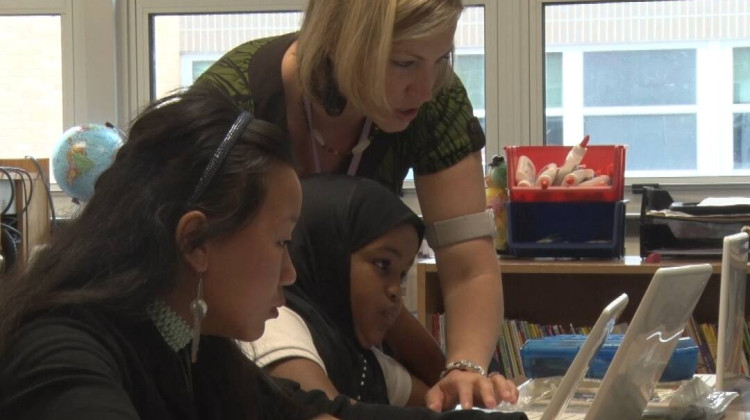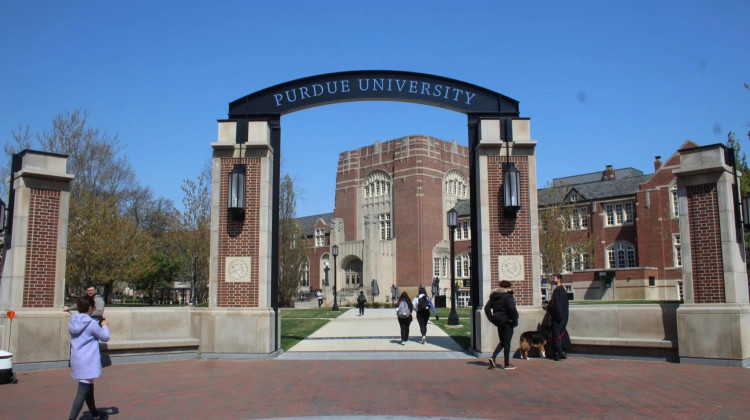Racial equity issues have been an afterthought – if mentioned at all – in most Indiana school board races in past years. But after this summer’s social justice protests, students and communities are demanding school boards address systemic racism and a wide range of connected issues.
Now, some candidates for local school boards, from rural and suburban parts of the state to Indianapolis, have no choice but to offer solutions to cultural and racial bias, access to high performing schools, curricula, and policing. Elected school boards have power to quickly address and change policies in almost all of the state’s 290 school districts
West Lafayette is one of the communities that saw the conversation on racial equity in education appear suddenly and become a centerpiece of the November school board election.
That’s where Ila Chaubey and Daniel Afolabi graduated from in 2016. They both laugh while thinking back to the good times when they crammed many activities into their schedules.
“I was very much like an academic, like a nerd, you know,” Chaubey said. “But my biggest activities on the extracurricular side were I swam for the swim team. And then I was also on the debate team.”
“Westside kids do like 1,000 different things,” Afolabi said.
Afolabi was on the track team and student council. The small school district, next door to Purdue University and its thousands of international students, provided seemingly unlimited opportunities for the high schoolers.
After Chaubey and Afolabi graduated, they left Indiana and went to college. That’s when they began to reflect on their high school experiences as students of color. Soon, their four years at West Lafayette high school seemed quite different than they initially realized.
“I didn't have my first teacher of color until junior high, and I didn’t have my first Black teacher until high school. And he was an elective teacher, not even like a mandatory class,” Chaubey said. “And that's something that, you know, you don't realize until you leave a bubble, like you go to college, and you think: ‘Wow, there were so many issues, right, that we just did not even notice, nobody pointed it out, nobody cared.’”
Those other issues, the two say, include a “white-washed curriculum,” one that relied on books by white authors and a Eurocentric view on history.
“I didn't necessarily see myself reflected all the time in some of our curricula,” said Afolabi, who said he experienced some insensitive comments and attitudes at the school.
Of the 2,400 students enrolled this year at the West Lafayette schools, 56 percent are white, 23 percent are Asian. Black, Hispanic and Multiracial students make up a combined 21 percent. Of the district’s 167 full-time teachers, 97 percent are white, according to the most recent state report.
The West Lafayette Letter
In June, as racial justice protests began around the country and the Black Lives Matter movement grew in awareness in smaller cities and towns, Chaubey and Afolabi joined other West Lafayette alumni in a public letter to their local school leaders.
The West Lafayette Community School Corp. must make significant changes to its policies and curricula, the alumni group wrote, to “support its Black and Indigenous students and other students of color; to educate all students on racial injustice; to give educators and students the tools necessary to dismantle systemic racism and white supremacy; and to work toward racial justice.”
Around 800 alumni, across six decades, initially co-signed the letter.
“With the elections coming up soon we thought this would be a good way to get this on the agenda that candidates were discussing,” Afolabi said.
That letter and stories shared by students are now a focus of the West Lafayette school board race, where 14 candidates are running for four seats in the A-rated district. Questions around equity have been asked of candidates by local media and in public forums.
The alumni group, called West Lafayette Coalition for Anti-Racist Education, also interviewed the candidates and endorsed four of them -- the only ones who agreed with the seven demands in its letter, such as adopting Black, Indigenous, People of Color-centered teaching curricula, ending a contract with the local police department to act as student resource officers, and hiring a director of diversity, equity and inclusion.
“We want to be very interactive with the next school board, and we want them to want to work with us. So the best way to do that, we felt, was to make the letter a priority for the candidates and to make it so that people were voting on the letter,” Chaubey said. “It really has become a conversation in the city beyond our group.”
Across The State
At the statewide level, the Indiana School Board Association is helping members understand and discuss issues of racial equity. Director Terry Spradlin said a major topic is diversifying teaching staff and administrators. Statewide, 93 percent of the nearly 78,200 teachers are white.
“We have more work to do to provide a framework for how to hold those conversations locally, and make them meaningful and intentional, and that they lead to, you know, action,” Spradlin said.
It’s unknown, Spradlin said, just how many school board races are having discussions around racial equity. Local schools’ response to the pandemic, he said, is another hot topic for some candidates.
No matter the issues in local races, he said, November could dramatically shift the landscape for how local schools are governed. The 2018 election brought 287 new school board members across the state.
Candidates are not equally engaged in this conversation statewide, but some across Indiana are under similar pressure to say how they will address racial equity.
In the suburban Hamilton Southeastern and Carmel Clay school districts candidates are addressing racial biases highlighted in stories posted by students on social media and reports of racism among students. Candidates have made a point to address the issues and some are making it a focus of their campaigns.
In the rural Brown County School Corp., the local chapter of the League of Women Voters questioned candidates about how they would make LGBTQ students and students of color safe from bullying.
The school district recently attracted national attention after a Black student was listed as "Black Guy" in the recent high school yearbook.
Shari Frank, the Brown County chapter president, said members heard from teachers concerned about these topics and the league is working with a group of Brown County High School students on equity issues.
“The students are remarkable in their awareness of the issues and their commitment to work on finding ways to address issues of equity,” Frank said. “The level of interest among students is also very telling, and we think we should listen and learn.”
Other local chapters are asking candidates simillar questions. That's partly from the League of Women Voters passing a racial justice resolution at its national convention this summer in response to the killing of George Floyd.
Debate In Indianapolis
In Indianapolis, where most students are Black and Brown and a majority of board seats are on the ballot, the discussion is more nuanced.
This is Diane Arnold’s 14th year on the Indianapolis Public Schools' Board of School Commissioners, following multiple re-elections in District 4 and earlier appointments. There is no doubt, she said, this year, people are talking about systemic racism much more directly than ever before.
“I can’t imagine anyone would be against racial equity,” Arnold said. “I think it is, how do you believe we need to move forward in achieving it -- that is going to be the issue.”
For years, Arnold said, district leaders and the school board talked about learning gaps -- how the district’s White students passed standardized tests at a higher rate than their fellow students of color; and the academic gaps between middle class students and children from low-income families.
“We've always, I think, acknowledged that,” Arnold said. “I just don't think that there was that passion to really tackle that as an issue.”
That changed, Arnold and other districts staffers have said, when Aleesia Johnson became superintendent in June 2019 and soon made racial equity her top focus.
This summer, Arnold and other board members signed an anti-racist proclamation and acknowledged the district’s history of segregation and racial inequality. They pledged to reduce “bias, particularly racism and cultural bias, as well as factors affecting student achievement and learning experiences..."
“We're not just talking about raising academic performance, we're talking about diversity of staff, we're talking about diversity of vendors, we're talking about curriculum,” Arnold said about what is underway. “So it's a multifaceted issue that, you know, has lots of layers and lots of levels to it.
A dividing issue among candidates is the district’s policies to collaborate with charter and nonprofit school managers, known as innovation schools. Arnold said this option has allowed the board power to radically provide a long-failing school with new leadership and curriculum.
“I've never felt more confident,” Arnold said of district leadership and improvements ahead. “That's, that's the reason I wanted to stay on the board.”
But Christina Smith, Arnold’s challenger for District 4, said the district’s embrace of equity does not go far enough.
“If we are going to say that we are anti-racist, then we have to mirror that in every single decision that's made,” said Smith, who wants more transparency in the innovation school proces.
Smith, who has long been a vocal critic of the school board and its policies, points to enrollment policies as an example of white families keeping an edge in attending some of the most popular elementary schools.
The district, and Arnold as a board member, have tweaked its use of proximity boundaries for enrollment at magnet schools to create diversity, rather than families who live nearby getting the only shot to attend.
But the changes, Smith said, have been too slow.
“They chose to make little bitty tiny steps where they could have gone ahead and taken a leap and really, really lived the mantra of ‘Black Lives Matter’ and that we believe in equity,” Smith said. “And they've chosen not to.”
To provide equity, Smith said, there needs to be serious and difficult discussion about redrawing boundaries to make neighborhood schools and schools with boundaries less segregated.
“We can't do much about where people choose to move,” she said. “But we can do something about how we draw those boundaries and make them make sense.”
Incumbent Arnold and her challenger Smith, who are both White, agree they share a common goal: provide the best education for the city’s students. But for now, they don’t agree on all the ways to get there.
Early voting is underway across Indiana.
Contact WFYI education reporter Eric Weddle at eweddle@wfyi.org or call (317) 614-0470. Follow on Twitter: @ericweddle.
 DONATE
DONATE








 Support WFYI. We can't do it without you.
Support WFYI. We can't do it without you.